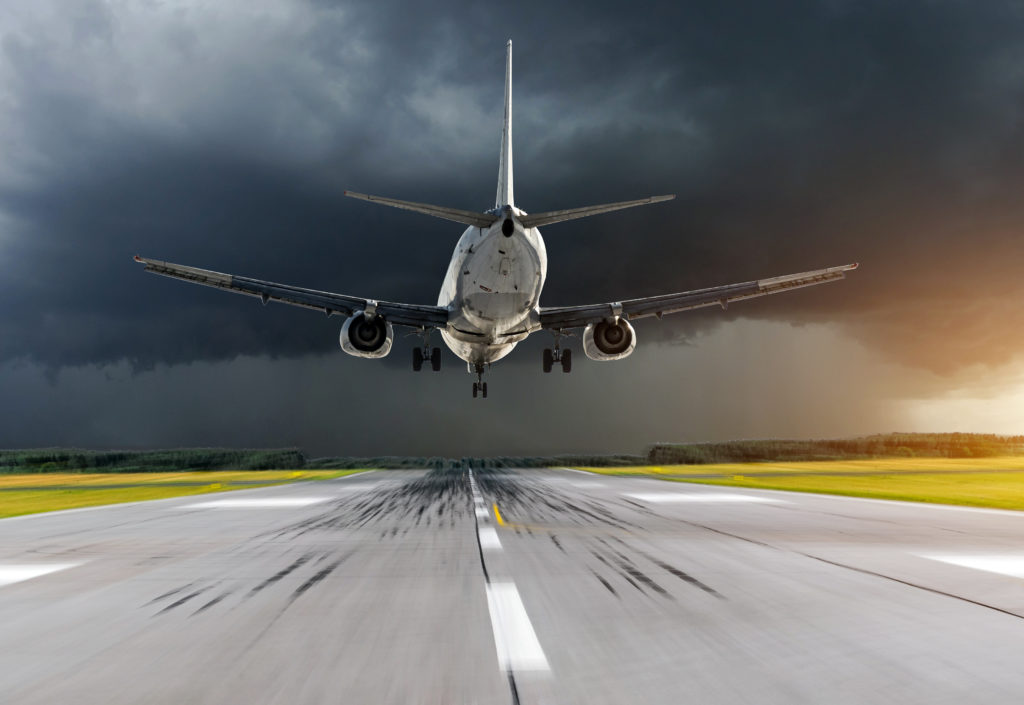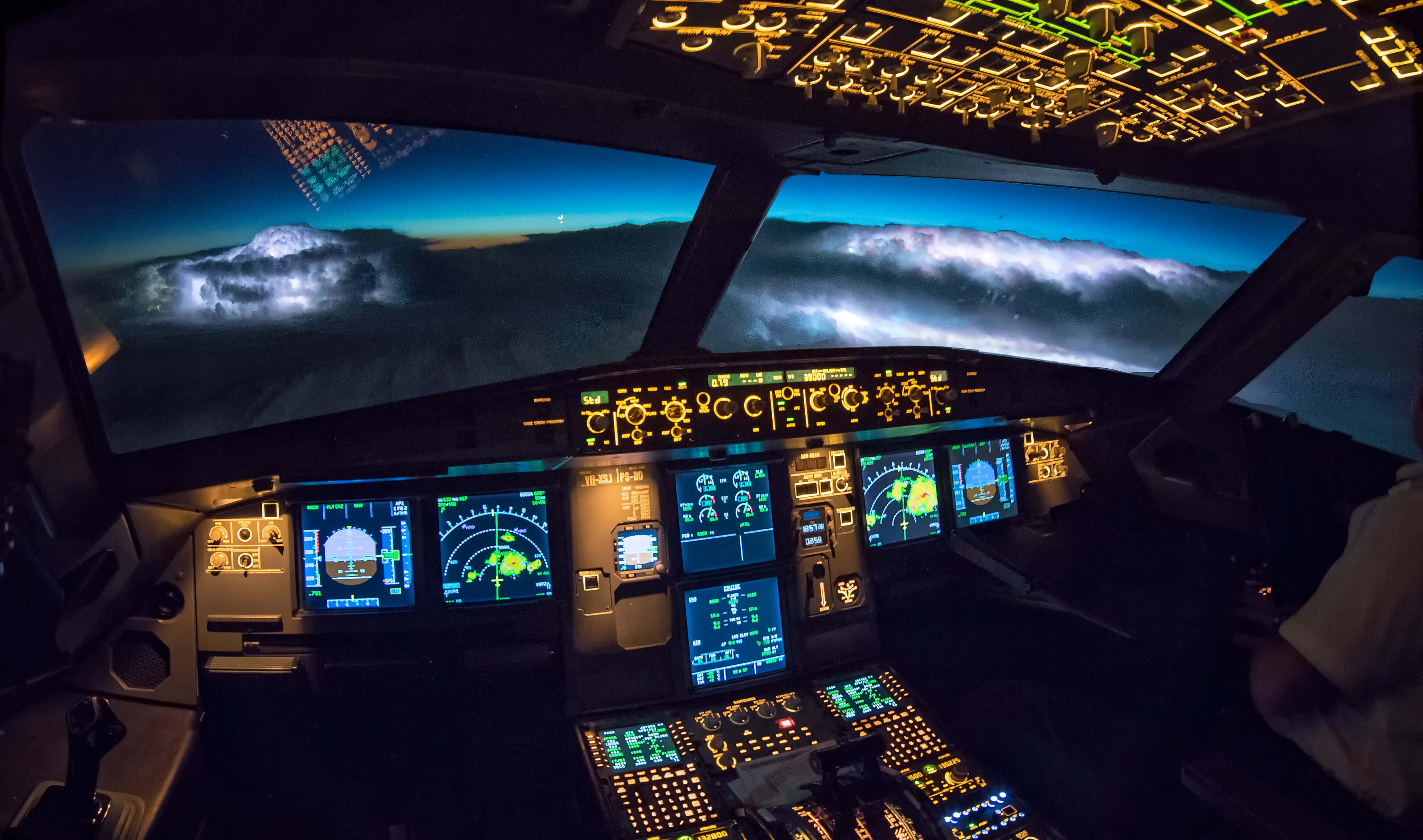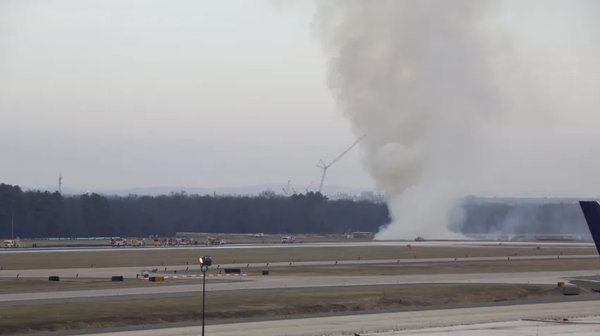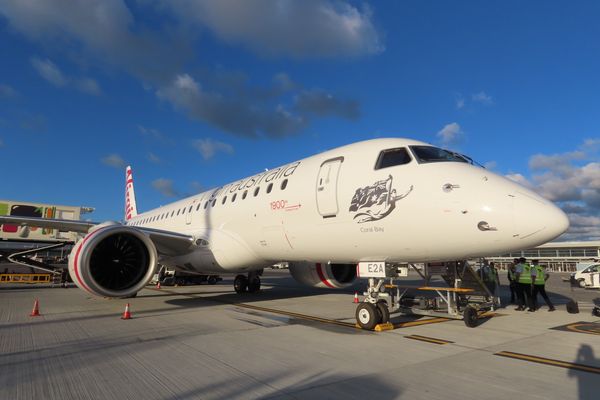
Whenever we step onboard a commercial flight, we are often greeted by the Captain’s announcement, informing us about the flight time, expected turbulence, and weather at our destination.
But where are the pilots getting their weather reports from? While most travelers will look at the weather app on their cell phones, pilots decode specific aviation weather reports known as METARs and TAFs instead. Let’s look at how pilots read weather reports and how you can, too.
METARs and TAFs
A METAR is a short form for Meteorological Aerodrome Report, a specific format for reporting weather at airports globally. METARs are real-time weather reports, typically generated every 30 minutes to an hour. They provide pilots and air traffic controllers with current temperature, wind gusts, wind direction, cloud level, atmospheric pressure, and more.
However, METARs can be issued more frequently if significant weather changes occur between each 30-minute interval. These special reports are called SPECIs and are denoted as such at the beginning of the METAR. This ensures pilots have the most up-to-date weather information to plan their aircraft's operation accordingly.

On the other hand, Terminal Aerodrome Forecasts (TAFs) are future weather forecasts. TAFs provide pilots with a meteorologist-produced forecast of what weather conditions they can expect over the next 24 hours.
Like METARs, TAFs provide predicted temperatures, wind information, cloud layers, and precipitation. This information is important for pilots who may have a longer flight and need to plan for the weather conditions at their destination.
How to Decode METARs
Let’s look at an example of a METAR for Washington’s Dulles International Airport (METARs for airports globally can be accessed at the National Weather Service website).
KIAD 291138Z 19009G15KT 7SM -SHRA SCT025 BKN045CB 24/22 A3007 RMK A02 SLP199 T02360221
While this may look intimidating, we’ll break down every part of this METAR weather report so you can read the weather like a pilot.

Station Identifier/Airport Code (KIAD)
The first part of a METAR is the station identifier. This unique four-letter code is different for every airport worldwide and is assigned by the International Civil Aviation Organization (ICAO).
These airport codes are slightly different from the International Air Transport Association (IATA) codes, which are three-letter airport signifiers that the general public may use.
For example, instead of Washington Dulles simply being IAD” with the IATA system, using ICAO codes, Dulles is known to pilots as KIAD. The “K” signifies the airport is in the 48 contiguous United States and can be different for airports in other countries.
Time and Date of Report (291138Z)
Second, in a METAR is the time and date when the report was generated. The first two digits of the number string designate the day of the month the report was taken. In our example, 291138Z would mean this report was taken on the 29th day of the current month.
After the date, the time of the report in Zulu time (UTC) is given. Zulu time, also known as Coordinated Universal Time (UTC), is the standardized time used in aviation, the military, and other industries. It corresponds to the local time at the prime meridian in Greenwich, England.

In this example, 291138Z would mean this METAR was generated at 11:38 Zulu time. To convert this to local time, you would have to look at the time difference between Greenwich, England, and the local time zone where the airport is located. For this example, Washington, DC, is four hours behind Zulu time, so the local time at KIAD would be 07:38.
It is also important to note that all times in aviation are reported in “military time” or on the 24-hour clock. Therefore, a time such as report at 152314Z would mean it was generated on the 15th day of the month at 23:14 Zulu, or 11:14 PM UTC.
Wind Information (19009G15KT)
After the METAR time and date, all the relevant wind information is given. Wind is one of the most important weather factors dictating flight. Pilots look to land and take off into the wind, so having the current wind direction and speed assists them greatly when operating their aircraft.
For our example, 19009G15KT, there is information about the wind direction, wind speed, and wind gusts. The first three digits, 190, indicate the wind is blowing at 190 degrees relative to true north. The next two digits represent the wind speed. In this case, the 09 means the wind moves at 9 knots (9 nautical miles/hour). The last part is only included in METARs if there is a substantial wind gust, denoted by a “G”. G15KT means there are gusts (G) of up to 15 knots (15KT).
Visibility (7SM)
Visibility is reported after the wind information. In our example, 7SM means there is visibility of 7 statue miles. For METAR reports in the United States, visibility is typically reported from 10SM down to M1/4SM (less than a quarter of a mile of visibility).

Precipitation and Other Obstructions (-SHRA)
Next, we report important weather elements that were observed when the METAR was observed. These elements can include precipitation, such as rain or snow, sometimes a descriptor of the precipitation, and may consist of sky obstructions, like fog or smoke.
Each type of precipitation has a different two-letter code in a METAR, listed as follows:
• RA - Rain
• SN - Snow
• DZ - Drizzle
• GR - Hail
• GS - Small Hail
• IC - Ice Crystals
• PL - Snow Pellets
The intensity of the precipitation can be described with a minus sign (-) for light precipitation, a plus sign (+) for heavy precipitation, or no sign for normal precipitation. For example, -RA means light rain, RA is just rain, and +RA signifies heavy rain.
Each type of precipitation can be further modified based on the weather phenomena, such as thunderstorms, showers, etc. This includes the following codes:
• MI: Shallow
• SH: Showers
• PR: Partial
• BC: Patches
• FZ: Freezing
• DR: Low Drifting
• TS: Thunderstorms
Lastly, METARs can include information about sky obstructions. These may include BR for mist, FG for fog, FU for smoke, VA for volcanic ash, HZ for haze, and many more.

In our example METAR, -SHRA, we see that the precipitation is light, as designated by the minus sign (-)—next, the SH signals showers, followed by RA, which means rain. Thus, -SHRA would mean light rain showers at KIAD.
Cloud Conditions (SCT025 BKN045CB)
Cloud conditions are especially important for VFR (Visual Flight Rules) operations. They provide pilots with information on the ceiling and further information on expected visibility.
Each entry in the cloud condition section will begin with how obscured the sky is. For example, SKC/CLR would mean clear skies, while OVC would mean overcast, meaning the entire sky is obscured.
Ranging from clear skies to overcast are three other distinctions: FEW (few clouds—1/8 to 1/4 obscured), SCT (scattered clouds—3/8 to 1/2 obscured), and BKN (broken clouds—5/8 to 7/8 obscured).
There can be multiple entries for cloud conditions, each listing a different cloud layer at different altitudes. To differentiate the different cloud layers, the altitude of the cloud layer is listed as three digits after the obstruction. SCT025 would mean scattered clouds at 2,500 feet.
The next layer above that, BKN045CB, is broken clouds at 4,500 feet. The additional two letters at the end, CB, means cumulonimbus clouds, a dense, towering vertical cloud typically associated with thunderstorms.
Temperature and Dewpoint (24/22)
After the cloud conditions, the temperature and dewpoint in Celsius are listed, separated as temperature/dewpoint. The first two digits, 24/22, indicate that the airport's temperature is 24 degrees Celsius. The last two digits, 24/22, mean the dewpoint is 22 degrees Celsius.
Altimeter/Barometric Pressure (A3007)
This part shows the atmospheric pressure in inches of mercury. This is designated by a leading “A” followed by four digits. Place a decimal point between the second and third digits to read the pressure. A3007 would mean 30.07 inHg at Dulles Airport, also known as the altimeter setting.
Remarks (A02 SLP199 T02330221)
Last but not least, after the barometric pressure, the remarks section includes any additional remarks that have not been included in the other sections. SLP199 represents the sea-level pressure in hectopascals. Here, it would be 1019.9 hectopascals.
T02360221 is the exact measurement of the temperature and dewpoint. The first four digits, T02360221, represent the exact temperature. A leading 0 before the last three digits means a positive temperature, while a leading one would indicate a negative temperature. After the temperature, the exact dewpoint is also listed. T02330221 would mean a dewpoint of positive 22 degrees Celsius.
Other information can also be included in the remarks section. For example, PK WND 19025/1543 would show the peak wind and its time. 19025 simply represents the wind in the same manner it is reported in the wind section of the METAR, and the four digits after the backslash indicate the time (Zulu time) that the peak wind was observed.

The amount of precipitation that has fallen can also be reported in the remarks. A “P” followed by four digits, for example, P0134, would mean 1.34 inches of rain have fallen (measured to the nearest hundredth of an inch). A listing of P0000 would mean no precipitation has fallen.
Reading TAFs
Reading a TAF is essentially the same as reading a METAR. Each entry lists the predicted conditions at a specific date and time. See for yourself if you can decode the sample TAF for Washington Dulles listed below! (Here’s a list from the National Weather Service of all abbreviations in METARs).
TAF:
KIAD 290435Z 2915/3018 20009KT 6SM OVC016
290500 19011G20KT 6SM BKN045 BKN100
290900 18008KT 6SM -SHRA VCTS BKN035CB
291300 21007KT 6SM -SHRA SCT025 BKN045
291700 25005KT 6SM SCT040 BKN150
Next time you go to check the weather on your phone, challenge yourself to decode the METAR for your local airport. Go to aviationweather.gov and read the weather reports like a pilot!
China Eastern Inaugurates New World's Longest Flight » Engine Failure Forces United 777 Emergency Landing, Starts Brush Fire at Dulles Airport » Making a Stopover in Dubai? Discover How to Book a Yacht and Explore the City in a New Way »
Comments (1)
 Uros
Can someone give an answer to the TAF so I could check to see the right answer?
TAF:
KIAD 290435Z 2915/3018 20009KT 6SM OVC016
290500 19011G20KT 6SM BKN045 BKN100
290900 18008KT 6SM -SHRA VCTS BKN035CB
291300 21007KT 6SM -SHRA SCT025 BKN045
291700 25005KT 6SM SCT040 BKN150
Uros
Can someone give an answer to the TAF so I could check to see the right answer?
TAF:
KIAD 290435Z 2915/3018 20009KT 6SM OVC016
290500 19011G20KT 6SM BKN045 BKN100
290900 18008KT 6SM -SHRA VCTS BKN035CB
291300 21007KT 6SM -SHRA SCT025 BKN045
291700 25005KT 6SM SCT040 BKN150
Add Your Comment
SHARE
TAGS
INFORMATIONAL Weather Aviation Weather Time Forecast Aviation Airport Airbus USA ICAO FAA METARs TAFsRECENTLY PUBLISHED
 Engine Failure Forces United 777 Emergency Landing, Starts Brush Fire at Dulles Airport
A United Airlines Boeing 777-200ER bound for Tokyo made a safe emergency landing at Washington Dulles International Airport (IAD) on Saturday afternoon after an engine failure shortly after takeoff ignited a brush fire near the runway. All 275 passengers and 15 crew members aboard United Flight 803 were reported uninjured.
NEWS
READ MORE »
Engine Failure Forces United 777 Emergency Landing, Starts Brush Fire at Dulles Airport
A United Airlines Boeing 777-200ER bound for Tokyo made a safe emergency landing at Washington Dulles International Airport (IAD) on Saturday afternoon after an engine failure shortly after takeoff ignited a brush fire near the runway. All 275 passengers and 15 crew members aboard United Flight 803 were reported uninjured.
NEWS
READ MORE »
 Making a Stopover in Dubai? Discover How to Book a Yacht and Explore the City in a New Way
Planning a stopover in Dubai? Learn how to book a yacht in Dubai and explore the city’s skyline, landmarks, and coastline from a private yacht.
INFORMATIONAL
READ MORE »
Making a Stopover in Dubai? Discover How to Book a Yacht and Explore the City in a New Way
Planning a stopover in Dubai? Learn how to book a yacht in Dubai and explore the city’s skyline, landmarks, and coastline from a private yacht.
INFORMATIONAL
READ MORE »
 Maiden Brazil: Virgin Australia Welcomes the Iconic Embraer E2
Known for its aging intrastate fleets and unmatched concentration of Fokker 100s, Perth Airport has been a time capsule for aviation enthusiasts. Now, Virgin Australia Regional Airlines is breaking tradition with the arrival of the cutting-edge Embraer E190-E2, ushering in a new era for Western Australian air travel.
TRIP REPORTS
READ MORE »
Maiden Brazil: Virgin Australia Welcomes the Iconic Embraer E2
Known for its aging intrastate fleets and unmatched concentration of Fokker 100s, Perth Airport has been a time capsule for aviation enthusiasts. Now, Virgin Australia Regional Airlines is breaking tradition with the arrival of the cutting-edge Embraer E190-E2, ushering in a new era for Western Australian air travel.
TRIP REPORTS
READ MORE »


